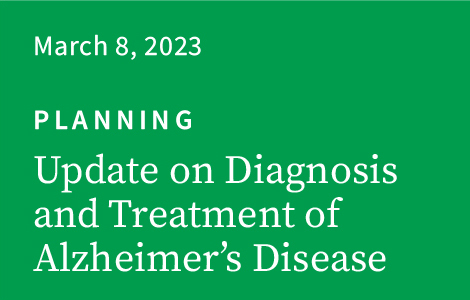Transcript
Update on Diagnosis and Treatment of Alzheimer’s Disease
We’ve made tremendous strides in our ability to diagnose Alzheimer’s disease and other causes of cognitive decline, of dementia in older people. And in terms of treatment, we’ve had a major scientific advance this past year, with the news that amyloid-lowering immunotherapies can slow down the progression of Alzheimer’s. I’ll be coming back to the new amyloid treatments, lecanemab, or Leqembi, as it’s called by its brand name. And aducanumab, or Aduhelm. But first, let me talk about where we are with diagnosis.
So, as we get older, we all experience changes in our memory and thinking. There are “senior moments” where you may have trouble remembering a name, or why you walked into a room. Or maybe it takes more effort to get organized and out the door in the morning. These experiences are almost universal as we age. But when it’s more than a little trouble, when there’s a significant difference in our memory and thinking from usual, and especially if it’s interfering with our daily functioning, this is a signal that there may be a disease. There are lots of causes of cognitive impairment. Not everything is Alzheimer’s disease. So it’s important to get a proper diagnosis with an experienced health care provider. The first step is to determine if there truly is a problem. Aside from recognizing the symptoms of memory loss, there are a number of good screening tools, brief memory and thinking tests, that can help see if there is a problem or not. Sometimes, though, it takes more in-depth testing by a neuropsychologist to suss out if someone has a memory problem. In Boston, we sometimes get these physics professors coming in worried that they have Alzheimer’s because they can only think 12 moves ahead in a chess game when they used to be able to think 18 moves ahead. And these folks may do fine on a cognitive screening test, but based on where they started from, they actually may have a serious problem emerging. And so a neuropsychology evaluation could help. Then it’s important to have a good general medical checkup with lab tests. Thyroid disease, certain vitamin deficiencies, side effects from some medicines people use for sleep or bladder control, can cause memory problems. Depression is another condition we want to be on the lookout for. Most everyone has ups and downs, but if depression takes hold, everything in the brain can shut down. Thinking and memory get foggy, and it can look like dementia. We also recommend an MRI or CAT scan of the brain to make sure there are no tumors or fluid collections or silent strokes. Some of these conditions that we discover from time to time also are quite treatable. If there is a noteworthy cognitive decline, and a good medical and neurologic exam doesn’t turn up any alternative explanations, then statistically, Alzheimer’s is the most common cause in people over 60. But there are other causes that can look very similar. Vascular cognitive impairment is due to the long-term effects of high blood pressure, affecting small blood vessels feeding the brain. They used to call this hardening of the arteries.
Lewy body disease is a cousin of Parkinson’s disease that also causes symptoms that overlap with Alzheimer’s disease. Frontotemporal dementia is another, and there’s a very long list of other rare conditions that do so, too.
We used to say that the only way you could be 100 percent sure that a person has Alzheimer’s was if you looked at brain tissue under a microscope after they’d died, and it showed the telltale amyloid plaques and tau tangles of Alzheimer’s disease. Based on the clinical symptoms alone, even the most experienced Alzheimer’s neurologist is correct with the diagnosis only 70 percent or maybe 80 percent of the time. And this may have been okay when we had no real treatment for Alzheimer’s, but now it’s not good enough, as we enter a new era with medications that specifically target Alzheimer’s disease, amyloids, but also come with some possibly serious, even fatal, side effects. And we need to be very confident in our diagnosis if we’re going to give someone one of these medicines. And diagnosis is where the Alzheimer’s field has made huge progress. If the disease is defined by the amyloid plaques and tau tangles, then we have to be able to detect and measure them to make a certain diagnosis.
We now have a range of biomarker tests that can tell us if there are plaques and tangles in the brain with very high certainty—almost 100 percent. So the most widely available are spinal tap tests that measure amyloid and tau in spinal fluid. But there are also PET scans that use radio-label tracers to show brain amyloid on X-ray—and these amyloid PET scans are expensive and not widely available or used, but if positive, they are diagnostic of the disease. There are also PET scans to measure the amount of tau tangles in the brain with Alzheimer’s. And these are still only used in research, where they’re especially helpful in measuring how far the disease has spread through the brain. The newest, most exciting, and potentially transformative advances coming right now are diagnosis with blood tests. These are mostly used in research so far, but new ultrasensitive laboratory tests can measure the very low levels of tau proteins that leak out into the blood from the brain or spinal fluid. And if the tau levels are high, the accuracy for diagnosis, based on the blood test, compared to spinal fluid or PET scans, is around 90 percent. This is good enough for screening, but if you’re about to commit someone to a new course of immunotherapy, you’ll need to be even more certain with a spinal fluid test or PET scan.
So let me move on to treatment. There are medicines like donepezil, or Aricept; rivastigmine, or Exelon; galantamine, or Razadyne; memantine, or Namenda; and we’ve had these for the last 20 to 30 years. These are safe, and most people have no, or very mild, side effects with them. But they provide only very modest benefits for some vague number of people—keeping people stable in their daily functioning for a little longer than if they were not taking them. But the big news over the last year is the accelerated approval by the FDA for two anti-amyloid immunotherapies, and a third drug in this family that’s likely to follow soon. Aducanumab and lecanemab are drugs that attack and clear out amyloid plaque proteins from the brain in Alzheimer’s. The drugs are administered by an intravenous infusion once or twice a month, and what we’ve learned from the large clinical research trials with these drugs is that they’re both very effective at clearing amyloid. Lecanemab reduces amyloid load in the brain an average of maybe 70 percent, and aducanumab even more, reducing amyloid maybe as much as 90 percent. And this reduction actually brings people’s amyloid levels back down almost to normal, if not normal. And as a secondary effect, they also reduce tau levels. So that is what the biomarkers show with these new drugs.
What happens clinically to people? This is what we really care about. Over the course of the 18-month clinical trial for lecanemab, most everyone in the placebo and the active lecanemab groups still got worse in terms of memory and functioning. But the people receiving lecanemab declined more slowly—27 percent more slowly.
Statistically, this was a highly significant difference and benefit for the active drug. For aducanemab, there were two big trials. One of them showed no clinical benefit between the active drug and the placebo groups. And the other showed marginally slower decline in the active aducanemab group.
Now, I want to emphasize that these findings are a huge scientific advance. After 40 years and billions of dollars of research chasing amyloid, these studies do, for the first time, convincingly demonstrate that if you can clear amyloid in the brain in people with Alzheimer’s, not just lab mice with Alzheimer’s disease, but people, that clearing this can moderate the clinical course of the disease. But do you change it enough to make a meaningful difference in someone’s day-to-day life? That’s still a question that we have. And at what risk and cost? About 20 to 40 percent of people can have side effects, including brain swelling and micro-hemorrhages. Most of these are benign and just noticed incidentally on MRI scans. But they can be serious, causing headache, stroke, seizures, or even death. And the financial cost of the drugs would be high, between $25,000 and $30,000 per year, plus the cost of infusion services, MRI scans, and other laboratory tests to monitor for side effects and more. So while they are successful, in that clearing amyloid or reducing amyloid does moderate the course of Alzheimer’s disease, it’s not enough. One thing that is clear in the data from these amyloid immunotherapies is that Alzheimer’s dementia is driven by more than just amyloid plaques or tau tangles. It’s complicated. You know there are important roles for inflammation, vascular factors, metabolic factors, oxidative stress, neuroplasticity, and many other fundamental cell biology factors that go off in the disease, and any combination of these may be even more important than the amyloid or tau. And that’s why continued research is so important into these contributors. But while the research moves forward, there are other things that we can all do now to optimize the brains we have, in whatever shape they are. Physical exercise, mental and social stimulation, a heart-healthy, brain-healthy diet, restful sleep and stress management. All of these are helpful. And for people in the throes of dementia, our most effective treatment is good care.
Question: Do we now accept amyloid and tau as causes of AD?
Dr. Arnold: So yes, but it’s not sufficient. I think we define the disease by the presence of amyloid and tau, the plaques and tangles of Alzheimer’s disease. And that’s actually how we’ve defined it since 1900, when Alois Alzheimer first started discussing it, or showing it. But I think that we do recognize that the causes may be much more complicated. And whether amyloid and tau are cause or consequence, or both, of more fundamental brain neuronal changes or inflammatory changes in the brain, that is still a question. For some people, it is primary. There are some rarer forms of Alzheimer’s disease that are genetically based. In other, more sporadic, and much more common, and heterogeneous, forms of Alzheimer’s disease, amyloid and tau may be part of the complicated web of changes that occur with aging, so it gets a little tricky to say that it is the cause. We know, and I think we do feel confident, that it is a contributor, and may be a major contributor, and for some people it may be the first cause, but for other people it may just be in the mix of things.
Steven E. Arnold, MD
Professor of Neurology
Harvard Medical School
Managing Director
Interdisciplinary Brain Center, Massachusetts General Hospital
www.actru.org

